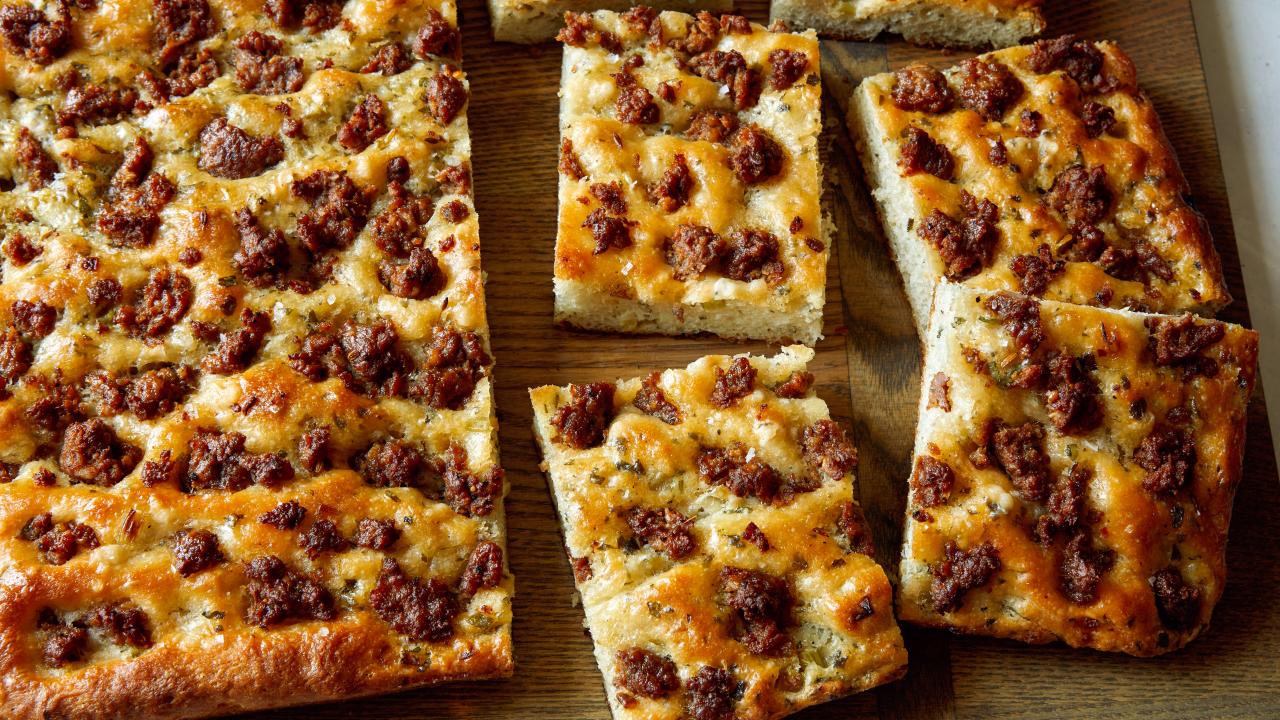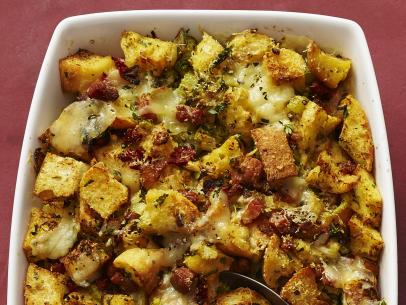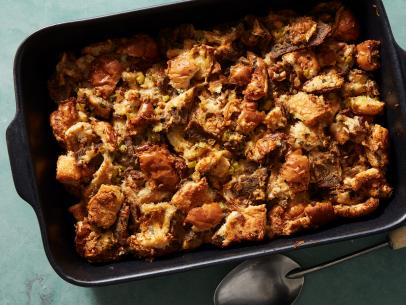Thanksgiving Stuffing Focaccia
- Level: Intermediate
- Total: 4 hr 45 min (includes rising and cooling times)
- Active: 1 hr
- Yield: 10 to 12 servings
-
- Nutritional Analysis
- Per Serving
- Serving Size
- 1 of 12 servings
- Calories
- 460
- Total Fat
- 21 g
- Saturated Fat
- 5 g
- Carbohydrates
- 54 g
- Dietary Fiber
- 4 g
- Sugar
- 2 g
- Protein
- 14 g
- Cholesterol
- 17 mg
- Sodium
- 469 mg
- Level: Intermediate
- Total: 4 hr 45 min (includes rising and cooling times)
- Active: 1 hr
- Yield: 10 to 12 servings
-
- Nutritional Analysis
- Per Serving
- Serving Size
- 1 of 12 servings
- Calories
- 460
- Total Fat
- 21 g
- Saturated Fat
- 5 g
- Carbohydrates
- 54 g
- Dietary Fiber
- 4 g
- Sugar
- 2 g
- Protein
- 14 g
- Cholesterol
- 17 mg
- Sodium
- 469 mg
Ingredients
Dough:
Brine and Finish:
Directions
- For the dough: Melt the butter in a large skillet over medium heat until foaming but not brown. Add the celery and onion and cook, stirring often, until softened but not brown, 12 to 15 minutes. Sprinkle with the sage, bouillon cubes and 1 teaspoon pepper and stir in 1/4 cup water. Cook, stirring often, until the bouillon is dissolved and has coated all the vegetables and the water has evaporated, about 3 minutes. Transfer to a plate and let cool to room temperature.
- Meanwhile, whisk the flour, yeast and sugar in the bowl of a stand mixer. Using the dough hook on low speed, stir in the warm water and 2 tablespoons of the olive oil, mixing until the flour is completely moistened. Let stand 5 minutes.
- Add 2 tablespoons kosher salt and knead on medium speed for 5 minutes. (The dough will tighten up, then begin to relax. After 5 minutes, it will be very wet and stick to the bottom of the mixer but not the sides.) With the mixer on low, add the cooled vegetables and the parsley.
- Rub 2 tablespoons olive oil around the bottom and sides of a large mixing bowl (big enough to hold at least double the volume of the dough). Using a scraper or spatula, transfer the dough to the bowl, flipping once to coat completely with oil. Cover with a plate and let sit until doubled in size, about 2 hours.
- Meanwhile, heat 1 teaspoon olive oil in a medium pan over medium-high heat until shimmering. Add the sausage and cook, breaking it up with the back of a spoon, until golden and crisp, about 5 minutes. Transfer to a plate and let cool to room temperature.
- Pour the remaining 1/4 cup olive oil into the bottom of an 18-by-13-inch rimmed baking sheet. Use your hands to evenly distribute the oil along the bottom and up the sides. Scrape the dough into the baking sheet, flattening it slightly with your hands. Flip the dough once and gently stretch it to fit into an even layer in the baking sheet. (The dough may not stretch to the edges at this point. If it starts to pull back, let rest 10 minutes and re-stretch, making sure to pull from the center as well as the edges to get an even thickness.) Top evenly with the sausage and use your fingertips to make dimples over the surface of the focaccia, pressing firmly but not so hard you make holes in the dough.
- For the brine and finish: Dissolve 1 teaspoon kosher salt in 1/4 cup warm water. Drizzle over the surface of the focaccia, letting it pool in the dimples. Cover with an inverted baking sheet or cover loosely with plastic wrap that has been lightly sprayed with nonstick cooking spray. Let sit in a warm place for 45 minutes to relax and rise again.
- Meanwhile, preheat the oven to 450 degrees F.
- Uncover the dough and sprinkle with flaky sea salt. Bake, rotating the baking sheet once halfway through, until the focaccia is deep golden brown on the top and bottom, 30 to 35 minutes. Drizzle with the olive oil and let sit for 5 minutes. Use a spatula to remove the focaccia to a wire rack to cool completely.
Cook’s Note
You can use bouillon cubes, powder or paste here. The important part is to use the amount of bouillon needed for 2 cups of water, based on the package directions. Cubes often vary in size and powder and paste have different concentrations. When measuring flour, we spoon it into a dry measuring cup and level off excess. (Scooping directly from the bag compacts the flour, resulting in dry baked goods.)
Looking for Something Else?
Related Pages
- 85 Best Stuffing and Dressing Recipes for...
- Thanksgiving Stuffing Do's and Don'ts
- Thanksgiving Stuffing & Dressing How-Tos
- To-Die-For Thanksgiving Stuffing Recipe
- Thanksgiving Stuffing Tips
- Share-Less Thanksgiving Stuffing Recipe
- How to Make Moist Stuffing
- Slider Thanksgiving Stuffing Recipe
- Thanksgiving Stuffing



































